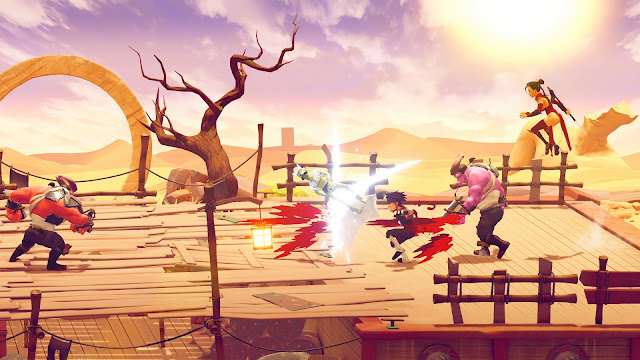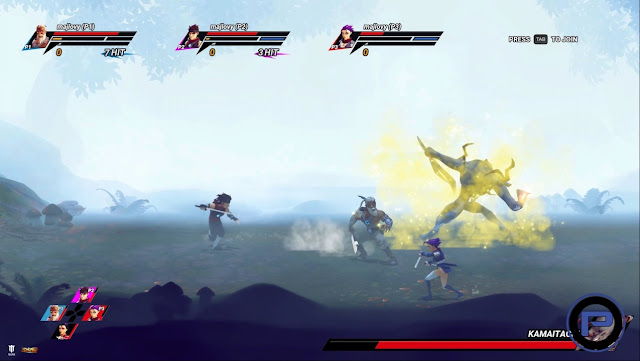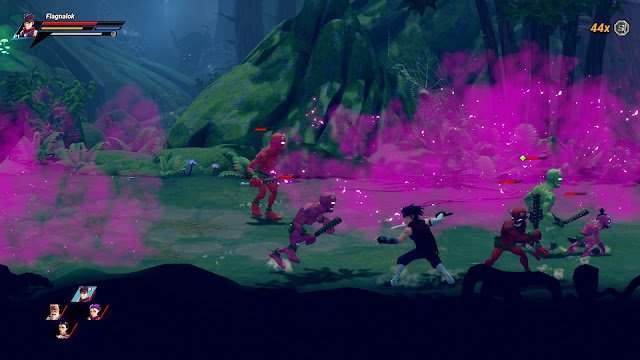Review by Harvard L.
My first few levels of SHING! were spent battling with my fingers to try and wrap around this game’s bizarre control scheme. It’s a brawler where the left stick moves and the right stick is used for attacks – flick in a horizontal direction to jab, draw an arc to do a strong attack, flick up to do a jumping attack and hold down to block. This sounds innocent enough, but it outright broke my button-accustomed brain.
I understand that brawlers are a saturated genre, so each new entry needs to differentiate itself somehow. Any modern beat-em-up, regardless of quality, needs to have an answer to the question of “why wouldn’t I just play Streets of Rage 2 instead?” This makes the genre stifling, but also creative: the differentiation could come from any angle, whether it’s aesthetics, narrative, difficulty, setting – SHING! just happens to have chosen controls.
In every other facet, this game upholds the genre conventions. Players choose from one of four ninjas and brawl through levels in order to save the world by securing an object so arbitrary that I have trouble remembering its name. Fighting happens on a 2.5D plane – mostly horizontal, with some movement up and down, and some potential for knocking enemies up for an aerial combo.
I really like the art style, as generic as it is. The developers have splashed for a wonderful intro cinematic with flashy action sequences, delivering on a powerful fantasy before the player even hits the start button. It’s easy to understate how significant this cinematic is. Even if the level-to-level combat gets repetitive, I can keep imagining the action of the cutscenes, and I feel a little cooler as a result. The levels themselves are done in a standard 3D style instead of the watercolours of the intro – though the pastels and hazy atmospheres are still pleasing to look at.
I only wish that animation budget went towards world building, characterisation and enemy design, in addition to all the cool fighting. The four playable characters are all some variation of 90’s cool dude, more interested in quippy insults than any meaningful interaction. The setting is also the generic Eastern Fantasy, with the most standard of humanoid demons serving as the antagonists. I know it’s silly to expect a deep and involving story from a brawler, but SHING! sits on the opposite end of the spectrum entirely. Case in point, it’s got a character named Bichiko. No prizes for guessing what her personality is like.
Because the game’s story and worldbuilding are so vacuous, SHING! relies on the player’s enjoyment of the combat to carry it forward. This means your enjoyment of this game will entirely hinge on whether or not you stomach the unconventional twin-stick combo mechanics.
I never quite acclimated to it, despite all the attempts I made to meet the game on its own terms. I think of it similarly to the horizontal and vertical slashes in The Legend of Zelda: Skyward Sword – I get that the developers were trying something different, and I can respect the novelty of mirroring a physical, analog input to the action the character takes on screen. And I also totally understand that to teach these changes, enemy designs should ideally require players to get comfortable with the unusual controls (in Skyward Sword it’s enemies which can only be defeated with a certain slash type, in SHING! it’s enemies that need to be juggled or otherwise they constantly hit you).
The problem though is that there’s nothing wrong with brawler mechanics themselves. The brawler genre is about the inherent fun within hitting things, and button controls make it effortless to successfully hit things. The joystick flicks that SHING! uses are inconsistent, and sometimes misread what the player is trying to do. It means that hitting things, the sole reason I choose to play a brawler, is harder to do. It’s as if a strategy game made it arbitrarily difficult to make strategic decisions. There’s no payoff. Compare with brawlers that do successfully reinvent the formula, like One Finger Death Punch or The Way of the Passive Fist – each one successfully presents a new type of challenge that mirrors the gameplay. But SHING! just feels like playing through a regular brawler with a more frustrating control scheme.
And on top of this general discomfort, the game layers enemies which test players in specific and tedious ways. My main problem is with the boss encounters – which are all very well designed from an intellectual standpoint, but are frustrating to actually execute. Most bosses need to be approached and attacked from a certain angle, with attacks that need to be blocked or sidestepped. And this is interesting, and it means bosses are memorable, but they’re also massive roadblocks until players get used to the proper plan of attack.
The Switch version does offer support for button controls, but this turns SHING! from an unwieldy yet interesting game, to a standard and boring game. Button controls make the combos effortlessly easy to manage, and also removes awkward button mapping issues like Right-Trigger for a kick and Right-Stick-Down for block. I ended up switching to button mode if ever I couldn’t get past a difficult boss or level.
Arcade-style brawlers are built for replayability – the first run, where you’re figuring things out, is not the most engaging, but the true fun comes in chasing high scores and mastering the systems. SHING! is no exception, providing a challenging Master mode as well as an interesting scoring system based on stylish kills. If players make their way through the main story (about four to six hours) and are itching for more, there’s a good amount of reward for those who want to push the game’s mechanics further.
But ultimately, I don’t know if SHING! will find its desired audience. The control scheme and deviations from genre standards leave a sour first impression, and it’s not helped by the vapid quality of the story and writing. The game is filled with schlocky Shadow Warrior style jokes at the expense of the Far East setting (fake-Asian words which sound like English swear words!), and bloody violence despite the immature Saturday-morning-cartoon simplicity. If a game is crass, it needs to have other qualities to redeem it, and SHING! unfortunately fails to justify its shortcomings. I can respect the desire to experiment and to break from tradition, but this game doesn’t do enough to be worth the investment.
– Harvard L.
Contributor











